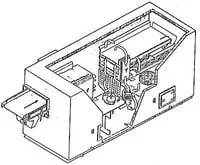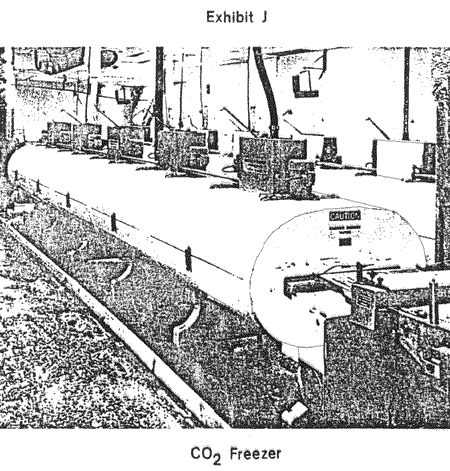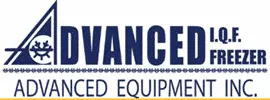Cryogenics VS Mechanical Freezing Systems
Most of us are fully aware that the U.S. does not have an energy policy. Our political system and politicians cannot seem to be able to solve the energy crisis. This obviously provides the management of a food processing plant with a rather obvious dilemma — How does he plan for the future? For decades, expending energy in lieu of capital. Buying the freezing system with the lowest capital cost, even though this system usually requires excessive energy. It was a good buy because he could expense the energy costs. Our existing taxation system still promotes this type of investment -- at the expense of our energy resources. Somehow, our country must find a way to regulate energy use equitably through legislation or taxation that will require the user to minimize the use of expendable energy, i.e., fossil fuels.
However, despite the absence of an energy policy, the rapid escalation of electrical energy costs has given management a real incentive to reduce energy usage.
To put these escalating energy costs Into perspective, let's look at 1970 costs vs. 1980 costs of capital and energy for a specific food freezing system. Let's assume that in 1970 a customer bought an l. Q.F. Fluidized Freezing System for 6000 pounds (2.72 ton) per hour of fried onion rings. This system costs about $235,000 and requires 600 BHP for operation, including all compression and ancillary equipment. The cost of electricity was about $1/KW or lower in most areas then. At 1 cent/K.W., if this system operated 4000 hours, the total yearly energy cost would be about $19,460. In 1980, just 10 years later, prices escalated, and the same system would now cost $510,000. Electricity has risen from 5 to 8 times. Assuming that electricity costs 5 cents/K.W., the operating cost for 4000 hours per year is $97,304. (See Exhibit A)
| EXHIBIT A MECHANICAL FREEZING SYSTEM 6000 POUNDS/HOUR
|
||||||||||||||||||||||||
Now, the investor must analyze his total owning and operating expenses and install an energy-efficient system to reduce the electrical energy requirements. In most cases, an additional investment of 5 to 10% will reduce operating expenses by up to 15%. With electrical costs in many areas of the U.S. at 8 cents and 10 cents/K.W., It will behoove investors to fully analyze their energy usage in any food freezing or other type of industrial refrigeration system.
So you save only 20 h.p. in your quest to reduce energy consumption. What is that worth? Lots. If you now pay 5 cents/KMW for electricity and operate the equipment for 4000 hours per year, you would save $3243 this year. However, if the cost of energy continues to escalate at 10% per year, in 20 years, you will have saved $186,058 or an average of $93O2/year. This projection type is well within the escalation predicted for energy sources by many experts.
While comparing cryogenics with mechanical freezing systems, we will compare liquid carbon dioxide and liquid nitrogen with a typical mechanical system that was designed for the same type of duty.
Freon freezents have been considered as cryogenics in some circles. However, due to the fluorocarbon/ozone controversy and the probability of restrictions being placed on using certain ha locations Freon freezents (F-12) comparisons have not been made. Over the last 10 years, Freon freezing has found very limited applications — mainly being used in the freezing of peeled and deveined shrimp, cob corn, and certain specialty items
Precooling is refuted
In addition to fully freezing food products, the cryogenic freezing proponents are now proposing precooling or preconditioning of products before they enter an existing mechanical freezer. This may apply to some older and inadequate freezers, but it is not the panacea Advertised. Most proposals indicate a saving of 5% for wet vegetables. This has been refuted by many authors, including Rasmussen. Any wet product such as peas, carrots, or diced onions carries considerable surface moisture, and even if dehydration occurs, the net effect on salable products is Insignificant. When a wet product is at 60oF. Enters a -25oF. To -30oF. In a high-velocity air blast (IQF Fluidized Bed Freezer), the external moisture is quickly frozen, thus minimizing the possibility of shrink loss. The potential shrinkage of the CO2 pretreating tunnel could be greater than that of the mechanical system, as the carbon dioxide could be as low as -80 degrees F. The vapor pressure differential would be much more than the mechanical system. Where wet vegetables or fruits are concerned, a refrigerated hydro cooler is the best approach to cooling before freezing.
Mechanical systems for freezing various products, such as fried onion rings or meat patties (the two items we analyze in detail), come in various configurations. Single, double, and triple belt in-line freezers and spiral freezers are used. Each has its specific applications.
EXHIBIT M

Single Belt
EXHIBIT N

Dual Belt IQF
EXHIBIT O

Multi Belt IQF
EXHIBIT P

Spiral
Quality fried onion rings freezing can be accomplished by either mechanical or cryogenic freezing. In each case, the quality is commercially the same. The shrink loss will be minimal provided the onion rings, either natural or fabricated, are introduced into the freezer immediately upon exit from the fryer.
Costs in Perspective
To keep energy costs in perspective, here is a basic cost analysis between liquid nitrogen, liquid carbon dioxide, and mechanical refrigeration. (See Exhibit B). Mechanical refrigeration is by far the miser in energy usage. Liquid carbon dioxide energy costs are 4.5 times mechanical and liquid nitrogen energy costs are 17.5 times mechanical. Because of liquid nitrogen high-energy usage, most cryogenic freezents suppliers started to switch their liquid nitrogen customers to liquid carbon dioxide as early as 1975.
EXHIBIT B
COMPARISON OF ENERGY USAGE FOR FOOD FREEZING SYSTEMS
KW/100 BTU
LIQUID N2 .383 KW
LIQUID CO2 .100 KW
The energy required to produce liquid nitrogen and liquid carbon dioxide are not the only energy costs effecting the total price of the delivered product. Liquid carbon dioxide is normally delivered by trailer to the User in an insulated tank designed to operate at 250 PSIG (-10° F). Liquid nitrogen is delivered similarly at atmospheric pressure (-320° F.). Liquid nitrogen trailers and customer stations usually cost twice that of comparable liquid carbon dioxide equipment. The cost of transportation exceeded the cost of liquid carbon dioxide production some 7 to 10 years ago — before the price of fuel started to rise.
Liquid carbon dioxide is selling at prices ranging from 2.5cents to 4.0 cents/pound delivered depending upon the plant location, and amount of freezant being used. Liquid nitrogen prices vary similarly, from 3.0cents/pound to 7.0cents/ pound. This varies quite drastically where the user's plant is adjacent to the liquid nitrogen manufacturing facility.
Thus, with the cost of electrical energy, gasoline, and diesel fuel rising at a rapid rate, both liquid nitrogen and liquid carbon dioxide will increase in price at a much more rapid rate than mechanical systems.
The physical characteristics of carbon dioxide that are relevant are: (Exhibit C)
I) Normal transportation and storage, 250 PSIG (-10° F.)
2) Triple point 60 PSIG (-70° F.). The element is a solid, liquid, and gas at this condition.
3) At atmospheric pressure, carbon dioxide exists as a vapor or solid only at -109° F. When used In a freezing system, there is about 140 BTU/pound available for freezing a product if the carbon dioxide is exhausted at about +0° F.
EXHIBIT C
TRANSPORT PROPERTIES OF NITROGEN AND CARBON DIOXIDE (CO2)
CARBON DIOXIDE (CO2)
250 PSIG (Liquid) -10 °F (-23.33 °C)
Triple Point 60 PSIG -70° F (Solid) (Liquid) (Gas)
Useful BTU/# 140
NITROGEN (N2)
O PSIG -320° F (Liquid)
Useful BTU/# 160
Nitrogen at atmospheric pressure exists as a liquid at -320oF. When used in a freezing system, there Is approximately 160 BTU/pound available for useful work if the vapors formed are exhausted at +0° F.
The selection of a freezing system for many products is relatively simple
Vegetable products such as peas, corn, Lima beans, carrots, and other staples are normally frozen in an IQF Mechanical System. These systems usually consist of one or two mesh belts which convey the product through an enclosure while being gently agitated by high velocity cold air (-20 to -25oF.) directed from beneath the belt.
Cryogenics are seldom used for such products, as their usage is, in general, limited to the following: (Exhibit E)
I) High-cost items
2) Freezers for small quantities
3) Freezers for test markets
4) Quality considerations
5) Advertising and sales advanced
EXHIBIT E
APPLICATIONS OF CRYOGENIC FREEZERS
(1) HIGH-COST ITEMS
(2) SMALL QUANTITIES
(3) TEST MARKETS
(4) QUALITY CONSIDERATIONS
(5) ADVERTISING AND SALES ADVANTAGES
Some facts were absolutely false
For many years, buyers of food freezing systems have been making decisions based on facts, some real, some imagined, and some that were absolutely false.
Cryogenic freezing proponents have been selling their system on the following criteria:
EXHIBIT F
1) A savings in shrink (dehydration)
2) A savings in capital investment
3) A quality motive
Except for a very few frozen products, mechanical systems can be designed to provide results comparable to cryogenic systems.
Most of the data never analyzed!
Dehydration or shrinkage is a very elusive criterion. It is most difficult to define and even more difficult to identify. Most of the data that has been published over the years has never analyzed cryogenic and mechanical systems of comparable design or quality.
Shrink or dehydration is difficult to measure. Shrink increases or decreases in accordance with the following:
EXHIBIT G
1) I) Vapor pressure between freezant and frozen item
2) Time required to freeze the product
3) Quality of food Introduced Into the freezer system
Cryogenic advertising claims are usually vague, and even data published by reputable Universities are usually based on the best cryogenic systems VS. the mechanical freezing systems of the 194O and 1950s. I quote from a study that indicated that cryogenic freezing of ground beef was the optimum process; (this is the last paragraph In a 30-page report): It should be noted in this study that the conditions chosen are not representative of freezing rates of which mechanical systems are capable. Rather, the experimental conditions were selected to represent those often used and, as a result, are representative of slow freezing. Any mechanical system that will decrease freezing time will probably decrease the quality differences noted in the study.
Considerable work has been done over the years in analyzing dehydration in freezing systems. It has been proven that dehydration Is minimal in air blast systems that are of proper design. Well-designed mechanical systems approach cryogenic freezing systems in both the areas of dehydration and freezing times as the vapor pressure differences are lower than cryogenic by about 60%, and the time to freeze-approaches that of cryogenic freezing.
The author has been involved in innumerable tests that indicate that the shrink for most products in a high quality mechanical freezer is generally difficult to measure as the time element is reduced to a minimum.
The deduction has been verified by Rassmussen in
Freezing Methods Related to Cost and Quality, i.e., The almost universal concern about evaporation losses during freezing is groundless. It is the evaporation during cooling that is critical. A product that enters the freezer at 32oF. Would have little dehydration in any type of freezer.
Dehydration or shrink is used as the sales approach for cryogenic freezers - It is not the major factor that it is reported to be. Quality as described by the cryogenic proponents is provided by quick freezing and low shrinkage. This may have some merit; however, it will only apply to a few products. A ground meat patty frozen in 5 to 8 minutes in a cryogenic freezer can be frozen in 6 to 8 minutes In a good mechanical system. The commercial quality and shrink difference would probably be difficult to determine. However, there are certain chemical reactions between red meat and carbon dioxide that provide advantages in shelf life, and so-called bloom or color.
Unfortunately, the Mechanical System companies have not seen fit to sponsor tests. By a qualified university research staff to prove that there is little, If any, difference in the cryogenic and mechanical system approach to freezing, either in shrink or quality.
Cryogenic Freezing Systems vary with products to be frozen.




Tumble Type Freezers


Each type has a particular application.
Each costs about 20% to 40% of its mechanical counterpart.
EXHIBIT Q
A cost comparison (Exhibit Q) indicates that the cost to freeze fried onion rings in a mechanical system is much less than in a liquid carbon dioxide or liquid nitrogen freezer.
EXHIBIT Q - COMPARISON OF FREEZING COSTS
|
|||||||||||||||||||||||||||||||||||||||||||||||||||||||||||||||||||||||||||||||||||||||||||||||||||||||||||||||||||||||||||||||||||||||||||||||||||||||||||||||||
The capital cost and organizing information was obtained from an onion ring freezing plant. The data was taken from their last year's operating cost analysis.
Another cost comparison (Exhibit R) Indicates the cost of hamburger patties in a mechanical system is much less than that experienced in a liquid carbon dioxide or liquid nitrogen freezer.
|
EXHIBIT R - COMPARISON OF FREEZING COSTS
MECHANICAL SYSTEM VS. LIQUID NITROGEN VS. LIQUID CARBON DIOXIDE
|
||||||||||||||||||||||||||||||||||||||||||||||||||||||||||||||||||||||||||||||||||||||||||||||||||||||||||||||||||||||||||||||||||||||||||||||||||||||||||
CONCLUSION
In analyzing various studies regarding hamburger patties using liquid nitrogen or liquid carbon dioxide the referenced tests indicate theminimal losses occur when the hamburger patty is frozen in less than 8 minutes from 40° F. to 0° F. in a -80° F. carbon dioxide atmosphere. There have been quite a few tests that
Indicate hamburger patties can be frozen in IQF Fluidized Freezers within 6 to 8 minutes with air at -35° F. to -40° F. with a minimum of so-called freezer burn or greying of the edges of the patty. The comparison offered have disregarded the shrink factor as mechanical systems can be designed to provide equal if not better performance than cryogenic system in regard to shrink and quality.
Over the last 8 to 10 years, several proponents of cryogenic freezing using liquid carbon dioxide have proposed a combination mechanical-cryogenic system whereby 70% to 90% of the carbon dioxide would be recovered, compressed to 250 PSIG, condensed by a two stage ammonia refrigeration system at -10°F. and reused in the freezing process. To date, this system has not been successfully applied to a food freezing system as far as can be, determined, It certainty has merit. Such a system would probably provide a freezing cost near mechanical freezing, with capital cost no more than mechanical, and provide all the quality features of both. You may expect to see future developments in this area.
CONCLUSION
Almost every frozen food product is better today than It was yesterday but nowhere near as good as it Will be tomorrow, and if we all do our job properly the freezing will be accomplished employing ammonia refrigeration systems using a minimum of energy.
REFERENCES
(I) Nitrogen Liquefaction in LNG Regasification Gazzi & Mattioti, IIR, Washington, D.C.
(2) Liquid Carbon Dioxide vs. Liquid Nitrogen in Food Freezing Airco Industrial Gases, Murray
Hill, New Jersey, 07974, November 1975.
(3) Freezing Methods As Related To Cost and Quality. C. L. Rassmussen & R. L.
Olson, Western Region Laboratories, U.S.D.A., Berkley, California, 94710.
(4) Cryogenic Freezing of Ground Beef. Cooperative Extension Service, Iowa
State University, Ames, Iowa, 50011. EC 1249.

